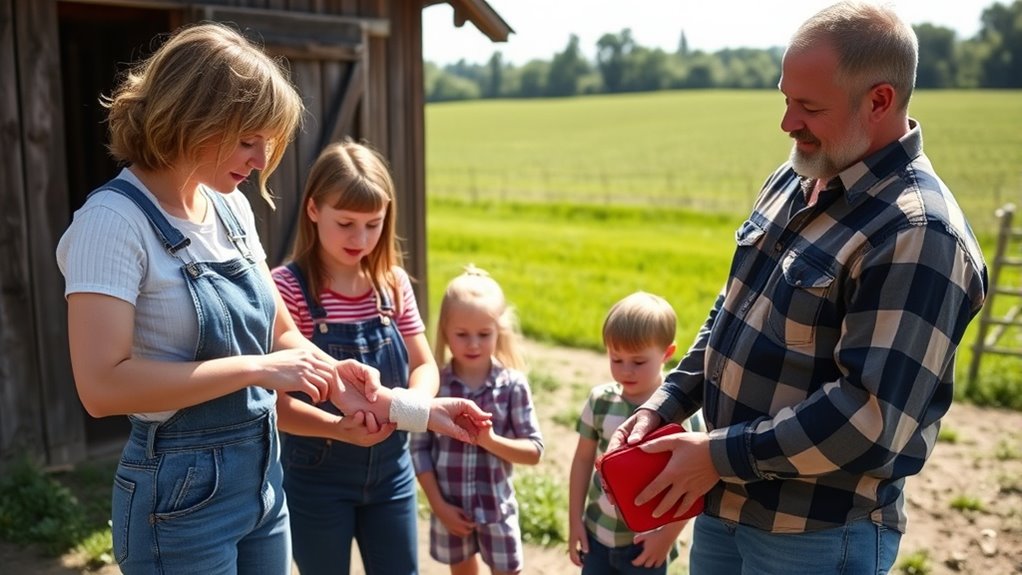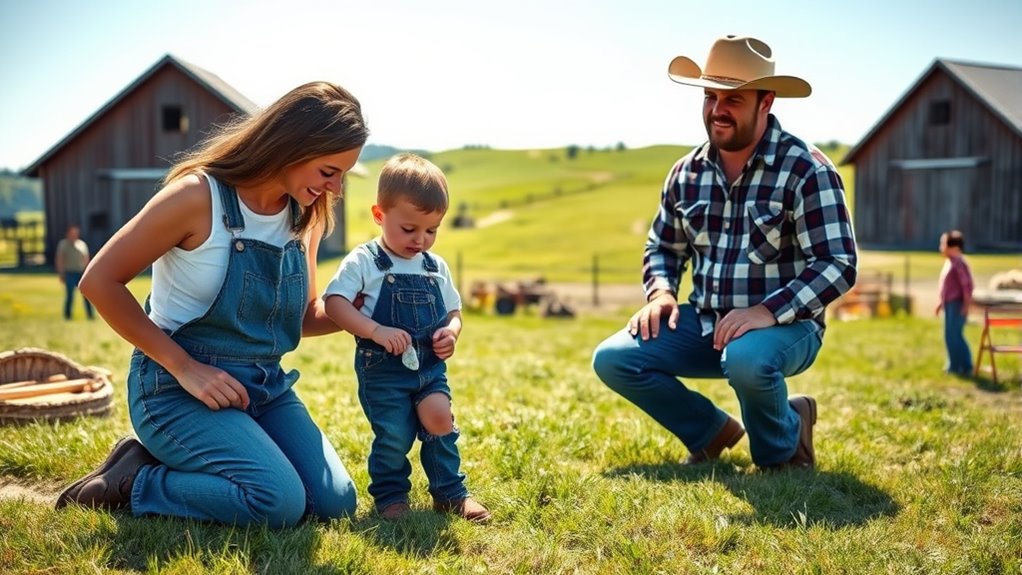To handle injuries on your farm, you need to learn basic first aid skills such as controlling bleeding with direct pressure, cooling burns with water, and recognizing signs of shock. Knowing how to perform CPR and use a first aid kit can make a essential difference in emergencies. Staying calm and acting quickly are important. If you want to be better prepared for farm injuries, there’s more you can learn to keep your family safe.
Key Takeaways
- Learn how to control bleeding with direct pressure and use sterile dressings.
- Know how to treat burns by cooling the area with running water immediately.
- Practice CPR techniques for unresponsive or breathing emergencies.
- Familiarize yourself with how to handle choking incidents safely.
- Keep a well-stocked first aid kit accessible and know how to use its contents effectively.

Have you ever wondered what to do if someone suddenly gets injured or unwell? As a farm family, you’re constantly working in a dynamic environment where accidents can happen unexpectedly. That’s why knowing basic first aid skills is vital—not just for responding effectively but also for promoting injury prevention and emergency preparedness. The more prepared you are, the quicker you can act, potentially reducing the severity of injuries and saving lives.
To start, understanding injury prevention is fundamental. Many accidents on farms stem from neglecting safety practices or overlooking hazards. Regularly inspect your equipment, tools, and work areas to identify risks. Keep walkways clear of debris, secure loose wires, and store chemicals safely out of reach of children or livestock. Educate everyone on proper handling techniques for machinery and animals. Wearing appropriate protective gear, such as gloves, helmets, and sturdy footwear, can considerably reduce the risk of cuts, burns, or falls. Small steps toward injury prevention create a safer environment and minimize the need for emergency interventions.
Regularly inspect equipment and use protective gear to prevent farm injuries.
Despite your best efforts, emergencies may still occur. That’s when emergency preparedness comes into play. Always have a well-stocked first aid kit accessible in key locations—your barn, tractor, or main house. Make sure it contains essentials like antiseptic wipes, bandages, scissors, tweezers, gloves, and any necessary medications. Knowing how to use these supplies is equally important. Take time to learn basic first aid procedures, such as how to stop bleeding, treat burns, or perform CPR. These skills can make all the difference until professional help arrives. Additionally, understanding how dreams are made can help you stay calm and clear-headed in stressful situations.
When an injury occurs, stay calm. Assess the situation quickly but carefully, checking for any potential dangers to yourself and others before approaching the injured person. If someone is bleeding heavily, apply direct pressure with a clean cloth to control the flow. For burns, cool the area with running water as soon as possible. If someone is unresponsive or not breathing, initiate CPR immediately and call emergency services. Remember, your quick, informed response can prevent complications and even save lives.
Being prepared also means having a communication plan. Keep emergency contacts handy and ensure everyone knows how to reach help quickly. Practice safety drills regularly, so your family knows what to do in different scenarios. The key is combining injury prevention strategies with emergency preparedness to create a safer farm environment. By doing so, you not only protect yourself and your loved ones but also foster a culture of safety that can handle unexpected situations with confidence and competence.
Frequently Asked Questions
How Often Should Farm Families Update Their First Aid Training?
You should update your first aid training every two years to guarantee your skills stay current. Regular first aid refresher courses help you stay confident and prepared for emergencies on the farm. The training frequency is important because protocols and techniques can change. By committing to this schedule, you ensure your family and coworkers are always ready to respond effectively, ultimately keeping everyone safer in potentially hazardous farm situations.
What First Aid Supplies Are Essential for a Farm First Aid Kit?
You should include essential supplies like antiseptic wipes, bandages, gauze, adhesive tape, scissors, tweezers, gloves, and antibiotic ointment in your farm first aid kit. Be prepared for farm animal injuries and common farm accidents. Regularly check and restock supplies. Follow farm safety tips by keeping the kit accessible and organized, so you’re ready to respond quickly during emergencies, minimizing injury severity and ensuring everyone’s safety.
How to Handle Allergic Reactions on the Farm?
If someone shows signs of an allergic reaction, act quickly by recognizing warning signs like swelling, hives, or difficulty breathing. Administer epinephrine immediately if available, following the device’s instructions. Keep the person calm and seated, and call emergency services. Monitor their breathing and be prepared to perform CPR if needed. Prompt treatment can prevent severe complications, so stay alert and act decisively.
What Should I Do if Someone Is Unconscious but Breathing?
If someone is unconscious but breathing, you should first guarantee their airway is open and clear. Check for responsiveness and call emergency services immediately. While waiting, perform emergency breathing techniques if their breathing becomes irregular or stops, and place them in the recovery position to maintain an open airway. Stay with them, monitor their condition, and offer reassurance until professional help arrives.
Are There Specific First Aid Considerations for Pesticide Exposure?
If you suspect pesticide exposure, immediately remove the person from the contaminated area. Use protective gear when assisting, and focus on pesticide decontamination by carefully rinsing the skin and eyes with clean water. Remove contaminated clothing promptly. Seek medical attention right away, and keep the person calm. Always wear proper protective gear during decontamination to prevent further exposure and guarantee safety for both of you.
Conclusion
By mastering these basic first aid skills, you hold the power to turn a moment of crisis into a manageable situation, saving lives and preventing disaster on your farm. Remember, your quick action can be as essential as a lifeline in a storm—it’s truly your most valuable tool. Keep practicing, stay prepared, and never underestimate the difference a simple first aid move can make. Your readiness could be the difference between tragedy and safety in the blink of an eye.









